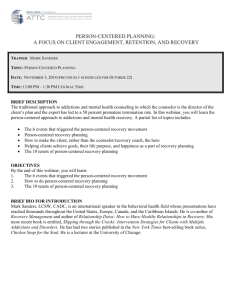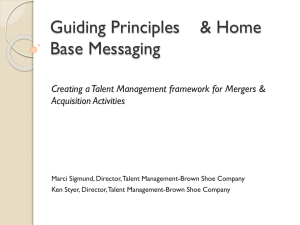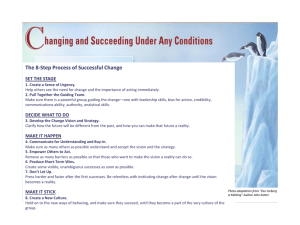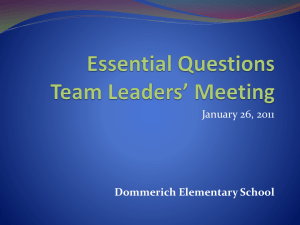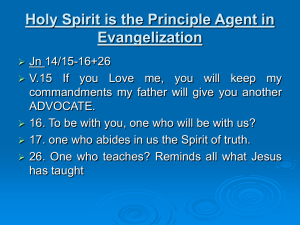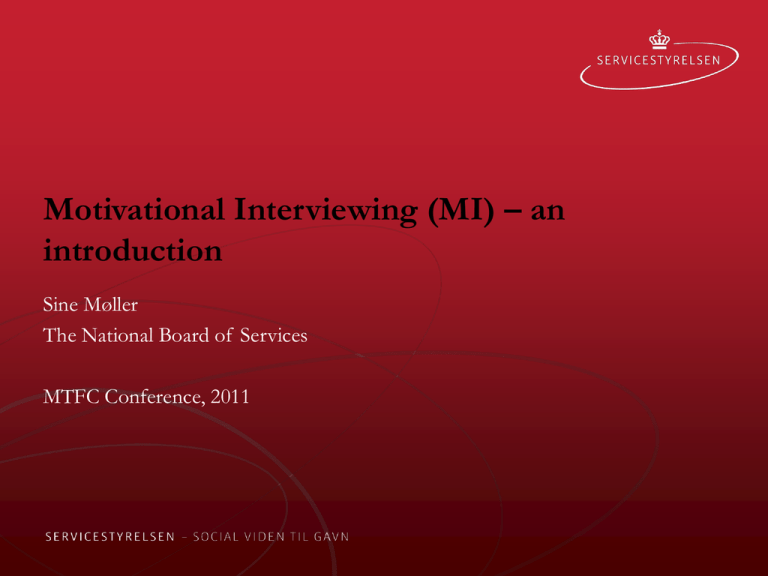
Motivational Interviewing (MI) – an
introduction
Sine Møller
The National Board of Services
MTFC Conference, 2011
Origins
Miller and Rollnick (both professors in psychology) started
developing Motivational Interviewing in the early ’80es.
The original MI book Motivational Interviewing: Preparing people to change
addictive behaviour came out in 1991.
Definition and purpose
”MI is a client-centered directive method for enhancing
intrinsic motivation to change by exploring and resolving
ambivalence” (Miller & Rollnick, Motivational Interviewing: Preparing people for
change, 2002).
“MI is a collaborative, person-centered form of guiding to
elicit and strengthen motivation for change” (Miller and
Rollnick, 2009).
Although the definition has changed MI is still an
interviewing method that is focusing on facilitating
behavioural changes.
Areas of application
MI was developed to facilitate behavioural changes in relation to
substance abuse. Since then the areas of application has spread
to:
• Smoking
• MI before or after psychotherapy
• Changes in health behaviour (diet, exercise etc.)
• Diabetes management and management of other chronic
diseases
• Adolescents and risk behaviour (for example unprotected sex
and drink-driving)
• Behavioural problems
What is MI?
MI themes:
Behaviour – it is difficult to change behaviour! If it was not, the client
would have made the changes on his/her own. Behavioural patterns
are often learnt over many years, and the client is often ambivalent
about changing disregarding the seriousness of the present
behaviour.
Motivation – is not static, you cannot insert motivation into people. The
therapist must facilitate the process of expanding the clients “inner”
motivation.
Resistance – is an interpersonal process and can be increased or
reduced by the therapist.
What is MI?
Commitment
Change
talk
Responding to
resistance
Person-centered guiding skills
From: Naar-King &
Suarez; Motivational
Interviewing with
Adolescents and Young
Adults. 2011. Guildford
Press
Spirit
The spirit
The MI spirit is characterised by
the
3 themes: autonomy, collaboration
and evocation.
resist the righting reflex
understand your clients motivation
listen to your client
empower your client
#
Commitment
Change
talk
Responding to
resistance
Person-centered guiding skills
Spirit
The spirit
When working with adolescents:
Support and guide without taking
responsibility for change.
In spite of the restrictions of
youth (from parents etc.) there is
still room for personal choice.
Commitment
Change
talk
Responding to
resistance
Person-centered guiding skills
Spirit
Person-centered guiding skills
MI is based on a Rogererian personcentered approach yet MI is also a
directive and goal-oriented
approach.
The guiding skills: OARS – Openended questions, Affirmations,
Reflections and Summaries.
It only takes a few minutes of active
listening to improve working
alliance with the client.
Commitment
Change
talk
Responding to
resistance
Person-centered guiding skills
Spirit
Responding to resistance
Resistance develops in an
interpersonal process. For
adolescent resistance is the norm!
Resistance talk, sustain talk and lack
of conversation.
Roll with resistance by stepping
back and not persuading.
Commitment
Change
talk
Responding to
resistance
Person-centered guiding skills
Spirit
Responding to resistance
Use reflections to respond to
resistance:
Commitment
Simple reflection (very few changes
to what the youth actually said)
Complex reflection (adds content or
meaning – reflects the meaning
behind what the youth said)
Amplified reflection (emphasize and
intensify – “there is no reason at
all…”
Change
talk
Responding to
resistance
Person-centered guiding skills
Spirit
Responding to resistance
RESIST THE RIGHTING
REFLEX!
Commitment
Change
talk
Responding to
resistance
Person-centered guiding skills
Spirit
Change talk
Any speech that favours movement
towards change: Desire, Ability,
Reason, Need, Commitment,
Activation, Taking steps.
Person-centered skills are used to
respond to and reinforce change
talk.
Commitment
Change
talk
Responding to
resistance
Person-centered guiding skills
Spirit
Commitment
Decrease in sustain talk and increase
in change talk in the form of
commitment language “I will…”, I
am going to…”, “I am ready…”
signals the time for developing a
plan for change.
Commitment
Change
talk
Responding to
resistance
Person-centered guiding skills
Use a summary and then ask a key
question: “What do you think you
will do?”.
Spirit
A taste of MI
•
•
•
•
•
•
Don’t persuade or fix.
Why would you want to make this change?
If you decided to make this change, how would you go about it to succeed?
What are the three best reasons for you to do it?
How important is it for you to make the change on a scale from 0 to 10?
So what do you think you’ll do?
Readiness for change
Ask questions about lifestile – the focus of the conversation
Not ready
Offer
Information
Create
discrepancy
Ambivalent
Ready
Explore
ambivalence
Support
Action and
Self-efficacy
Relapse
Follow-up
When the youth is not ready for change
Elicit – provide – elicit:
Ask for permission to give information – give the information (make it short!)–
ask what the client thinks of it. #
Use open/explorative questions to create discrepancy (is the current behaviour
fitting in with the life the youth wants to live).
When the youth lacks self-efficacy
Use the VAS-scale: “on a scale from zero to ten how much do you believe that
you have the ability to….”
Ask questions about past change successes and underline personal strengths
and/or social support.
When the youth is ready for change
Help the youth make a plan asking questions like:
What is your first move?
What do you have to do?
What do you need to succeed?
When will you start?
Pick the flowers of change talk and serve it to the youth in the form of a
summary.

